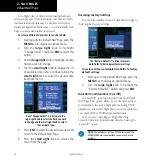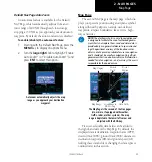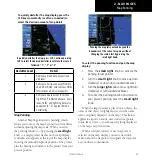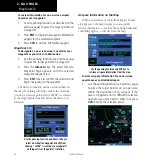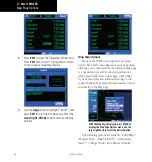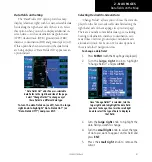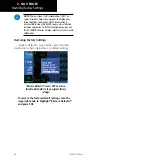
2 - NAV PAGES
43
190-00357-00 Rev G
Terrain Operation
During power-up of the 500W Series unit, the
terrain/obstacle database versions are displayed along
with a disclaimer. At the same time, the Terrain system
self-test begins. A failure message is issued if the test fails.
Garmin TERRAIN is a non-TSO-C151b-certified
terrain awareness system provided as a standard feature
of 500W-Series units to increase situational awareness
and help reduce controlled flight into terrain (CFIT).
TAWS is an optional feature on 500W-Series units.
Information on TAWS is provided in the
400W/500W
Series Optional Displays Addendum, p/n 190-00356-30
.
Operating Criteria
TERRAIN requires the following to operate properly:
• The system must have a valid 3-D GPS position
solution.
• The system must have a valid terrain/obstacle/air-
port terrain database.
Terrain Limitations
NOTE
: 500W-Series units may display either a TERRAIN
Page or a TAWS Page, (or neither, but not both) depending
upon the installed hardware and configuration.
TERRAIN displays terrain and obstructions relative to
the altitude of the aircraft. The displayed alerts are advisory
in nature only. Individual obstructions may be shown
if available in the database. However, all obstructions
may not be available in the database and data may be
inaccurate. Never use this information for navigation or to
maneuver to avoid obstacles.
Terrain information is based on terrain elevation
information in a database that may contain inaccuracies.
Terrain information should be used as an aid to situational
awareness. Never use it for navigation or to maneuver to
avoid terrain.
TERRAIN uses terrain and obstacle information
supplied by government sources. The data undergoes
verification by Garmin to confirm accuracy of the content,
per TSO-C151b. However, the displayed information
should never be understood as being all-inclusive.
NOTE
: The data contained in the TERRAIN databases
comes from government agencies. Garmin accurately
processes and cross-validates the data but cannot
guarantee the accuracy and completeness of the data.
TERRAIN Alerting
TERRAIN uses information provided from the GPS
receiver to provide a horizontal position and altitude.
GPS altitude is derived from satellite measurements. GPS
altitude is converted to a mean sea level (MSL)-based
altitude (GPS-MSL altitude) and is used to determine
TERRAIN alerts. GPS-MSL altitude accuracy is affected
by factors such as satellite geometry, but it is not subject
to variations in pressure and temperature that normally
affect pressure altitude devices. GPS-MSL altitude does not
require local altimeter settings to determine MSL altitude.
Therefore, GPS altitude provides a highly accurate and
reliable MSL altitude source to calculate terrain and
obstacle alerts.
TERRAIN utilizes terrain and obstacle databases that
are referenced to mean sea level (MSL). Using the GPS
position and GPS-MSL altitude, TERRAIN displays a 2-D
picture of the surrounding terrain and obstacles relative
to the position and altitude of the aircraft. Furthermore,
the GPS position and GPS-MSL altitude are used to
calculate and “predict” the aircraft’s flight path in relation
to the surrounding terrain and obstacles. In this manner,
TERRAIN can provide advanced alerts of predicted
dangerous terrain conditions. Detailed alert modes are
described later in this section.
Terrain Operation
Summary of Contents for 500W Series
Page 1: ...500W Series Pilot s Guide Reference ...
Page 10: ...INTRODUCTION viii 190 00357 00 Rev G Blank Page ...
Page 68: ...2 NAV PAGES 58 190 00357 00 Rev G Blank Page ...
Page 92: ...4 FLIGHT PLANS 82 190 00357 00 Rev G Blank Page ...
Page 158: ...6 WPT PAGES 148 190 00357 00 Rev G Blank Page ...
Page 234: ...APPENDIX D Index 224 190 00357 00 Rev G Blank Page ...
Page 235: ......




